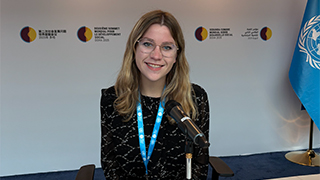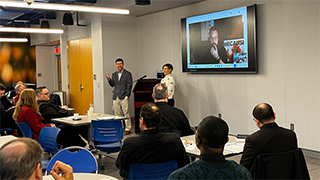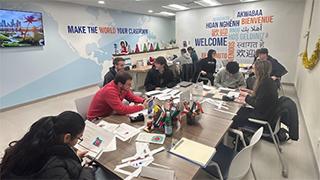Innovating Futures in STEM: Giant LEAP STEM Academy
Thursday, October 16, 2025
On July 11, 2025, another dozen enterprising young high school students joined the graduate ranks of Seton Hall University’s own Giant LEAP STEM Academy. Giving high school students a robust introduction to the world of scientific research and a preview of their prospective STEM careers, this summer program focuses on providing both foundational knowledge and an advanced hands-on learning experience, helping to ensure they are well-prepared for their future academic and professional pursuits.
Collaborating with Seton Hall University’s Laboratory of Electro-physics and Atmospheric Plasmas (LEAP), students worked together with faculty and researchers in small groups to tackle a range of scientific questions and technological challenges spanning the multidisciplinary STEM field. This year, theprogram featured an exciting array of topics, including mechanics, electronics, robotics as well as climate and sustainability. Students had to dive in head-first as they were not only required to learn these topics but also demonstrate their proficiency in this accelerated applied-science based program.
Mechanics:
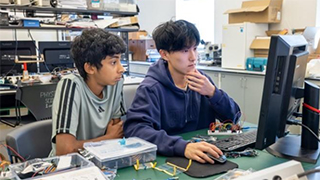
Applying physics beyond the classroom, where concepts of motion and momentum met real-world design and innovation
From vectors to kinematics, Newtonian motion to the conservation of momentum, participants took a deep dive into the fundamental forces of physics governing the world around us. Reinforcing their newfound knowledge, this experiential course had them apply what they learned in creative projects each step of the way. Beit egg drops or bridge construction, via hands-on building potato cannons or virtually designing in Auto-CAD, this workshop challenged their math & core skills and supported student’s success in fun & engaging ways.
Electronics:
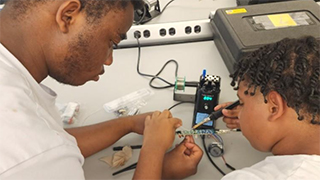
Exploring the science behind electricity and innovation, from wiring circuits to coding Raspberry Pis.
What is electricity? How do we harness it to power our world? How do motors work? What is a computer chip? In this workshop students learned what goes in to making the modern “technological” world. From the basic concepts of conductors and resistors to how to put these pieces together in complex electronic circuits, students gained not only a foundational understanding of how electronics but also developed a practical skillset of how to do it themselves. By first learning how to build and solder their own circuits, then by covering logic and Python programming, participants walked away with not only their own Raspberry Pi computers but also the ability to become the innovator making the next-gen technology.
Robotics:
What’s the difference between machines and robots? What is robotics? In this tutorial, students learned how to create robots by designing machines with greater autonomy, featuring programmability, intelligence and incorporating sensors to perform tasks with little to no human intervention. With an introduction to basic electronic components, a crash-course in CAD-CAM and 3D printing and a splash of C++ programming, students learned how to wire and program their own Arduino DIY microcontroller kits, enabling them to carry out any tasks they could think of and giving them the skillsets to be on the forefront of one of today’s most useful STEM skillsets.
Weather, Climate and Environmental Sustainability:
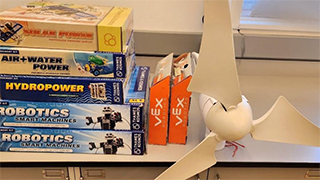
Students became climate scientists with the help of DIY weather and robotics kits.
In this workshop, students learned the science behind what exactly makes up the day-to-day weather we experience and how all our actions are affecting the world-wide climate crisis we are challenged with today. By going out into the field to collect environmental samples and meteorological data, students will analyze weather patterns to make weather forecasts and forecast climatological impact trends. An in-depth analysis is also carried out to compare alternative energy sources, and a creative study is conducted to design potential mitigation strategies. This course cuts-through the rhetoric letting students walk away with the real socioeconomic, scientific and engineering challenges our society faces and the tools to make an impact – including a DIY weather station!
Reflections:
Professor Daniel Guerrero, lead faculty for the workshop, reflected on the program’s impact, “Providing these young minds with real-world scientific experience is crucial. It was inspiring to see their curiosity and innovation come to life in the projects they undertook.”
Joshua, a participating student, said,
As a student of the camp I had a great experience. I enjoyed every minute, and learned new things such as hydraulics, aerodynamics and how cars, planes, and trucks work. The staff at the camp consisted of both grad students and professors. They taught with a hands-on approach which made the course both interesting and challenging. I think that anyone who is interested in mechanical engineering would benefit from spending a week with these brilliant students and professors.
The program also underscored its commitment to inclusivity and accessibility. As emphasized by Jose Lopez, Ph.D., professor of Physics, the program strives to make STEM opportunities available to a broader range of students through increased efforts to reach socioeconomically minorities groups otherwise underrepresented: “By making STEM education accessible, we’re not only nurturing future scientists and engineers but also ensuring diverse perspectives in these critical fields. This inclusivity drives innovation and progress.”
Looking Forward:
As the demand for STEM professionals continues to grow, it becomes increasingly critical to captivate and inspire young minds early on. It is through initiatives like the Giant LEAP Summer Science Academy that Seton Hall University continues to pave the way for the next generation and help develop our nation’s scientists, engineers and future STEM leaders.
Click here to learn more about the program.
For more information about Pre-College offerings at Seton Hall, please contact [email protected].
Categories: Education, Science and Technology



